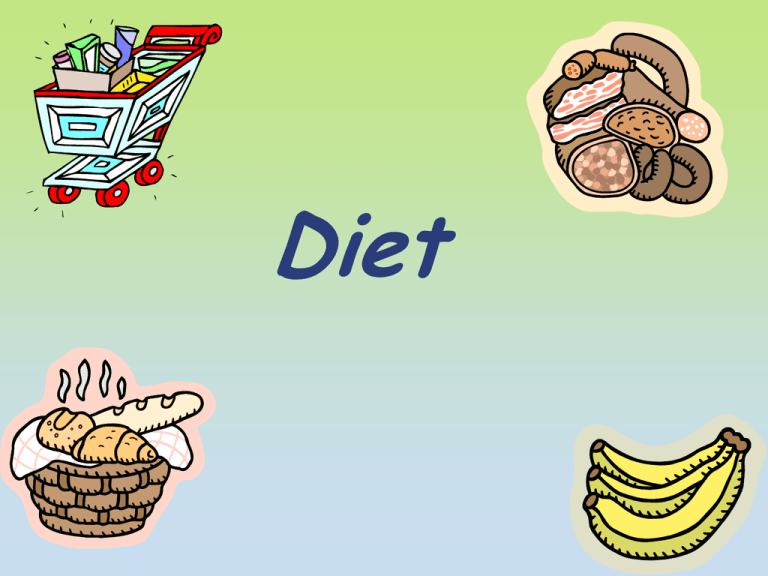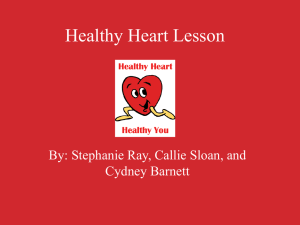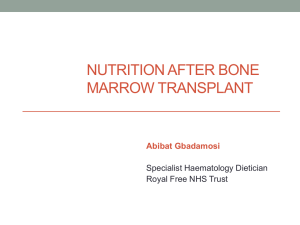
Diet
A healthy diet consists of a balance of
energy giving foods and those that the
body needs for growth and repair.
Energy Foods
1.Carbohydrates : theses foods are
starchy or sweet .
eg. Cereal, bread,
cake.
2. Fats : these foods are oily or fatty.
eg. Chips, butter, bacon.
A healthy diet consists of a balance of
energy giving foods and those that the
body needs for growth and repair.
Energy Foods
1.Carbohydrates : theses foods are
starchy or sweet .
eg. Cereal, bread,
cake.
2. Fats : these foods are oily or fatty.
eg. Chips, butter, bacon.
Foods needed for growth and repair are :
3. Proteins : good sources are fish, meat and
nuts.
4. Vitamins and Minerals : these are found
mainly
in fruit and vegetables.
Diet or eating habits is one factor that
determines a persons weight.
People who are overweight or obese are likely
to suffer heart disease or diabetes.
160
Mass 140
(kg) 120
Very obese
obese
100
80
overweight
ideal
60
40
20
0
1.5
1.6
Height in (m)
1.7
1.8
1.9
Activity
Measuring Height and Weight
Measure your height using the height chart on the
wall.
Weigh your self on the bathroom scales.
With a pencil , draw a straight line across your
chart with
a ruler at your weight.
Now draw a straight line up at your height.
Where the 2 lines meet will indicate your weight
type.
Daily Balance
Milk/dairy
Fat/sugar
Fruit /
vegetables
Meat/fish
Bread /
cereal
Use the pie chart and graph to answer the following
questions :
1. Which food group gives you the most energy
2. Why do you need a large amount of fruit and
vegetable
each day ?
3. Meat and fish are made of what kind of food ?
4. John is 1.70 m tall and weighs 85 kg. Use the
graph and comment on Johns weight.
5. Would you need any other information before you
recommend
John lose weight ?
Energy requirements
The total amount of energy required per
day depends on several factors such as
the person’s
Age: adults and growing teenagers need more
energy than young children
Sex: men normally need more energy than
women
Size: people with a bigger body frame need
more energy than those with a smaller build
Occupation: people with active jobs require
more energy
Lifestyle: some sports and activities use up
more energy than others.
Person
Daily energy
requirement (kJ)
2 year-old child
6 year-old child
12-15 year-old girl
12-15 year old boy
Woman (light work)
Woman (pregnant)
Woman (heavy work
Man (light work)
Man (moderate work)
Man (very heavy work)
5000
6500
9600
11700
9500
10000
12500
11500
13000
15500
The importance of energy
balance
If the energy taken in by a person
equals the energy the use up, they
are energy balanced and will not lose
or gain weight.
If more energy is taken in than used
up, a person will gain weight.
If less energy is taken in than used
up, a person will lose weight.
Leisure activity
Approximate
energy used per
hour (kJ)
Watching TV
400
Walking
1000
Swimming
1500
Tennis
1700
Football
2150
Running
2500
Boxing
3200
Body fat
The human body needs fat for a
variety of reasons:
Acts as an energy store
Used under the skin to insulate the
body by reducing heat loss
Fat pads in hands and feet absorb
shock
Required to make nerve cells work
Measuring body fat
The body of a healthy adult female
should contain 20-25% fat and a male
should have 15-20%.
Body fat can be measured using a
skin fold calliper (low tech) or a fat
sensor (high tech).
Using a skin fold calliper
Measurements taken in four key
positions on right-hand side of body.
A fold of skin is taken between
thumb and index finger and calliper
is applied to the fold.
Add the four average results
together then refer to % fat content
table provided by your teacher.
1
Back of arm
Front of arm
Waist
Below shoulder
blade
Total
Percentage
2
3
Average
Body temperature
Our body must be kept at a constant temperature
between 36 and 37.3°C in order to work efficiently.
Body temperature can alter slightly depending on
where it is measured, the time of day and in
women, the time of month (menstrual cycle).
The brain acts as a thermostat to maintain a
constant body temperature.
A body temperature above 40°C can
lead to heatstroke or indicate fever as a
result of fighting infection.
A body temperature below 35°C
indicates hypothermia. If the
temperature of the body falls below
30°C, death can result. Babies and the
elderly are particularly at risk.
We can measure body temperature using:
a clinical thermometer
a liquid crystal thermometer
a digital clinical thermometer
Measuring Body Temperature
Temp. (ºC) Temp. (ºC)
Clinical
thermometer
Liquid crystal
thermometer
Digital thermometer
1. Which thermometer do you think
gives the most reliable reading of your
body temperature?
2. Which thermometer is the easiest to
use?
Exercise and healthy
muscles
Most of the energy obtained by food
is to help us move.
All movement is brought about by
the action of muscles.
When muscles contract they become
shorter and fatter and the parts of
the body they are attached to move.
After contraction, muscles relax and
return to their original shape.
Muscles must work in pairs and the
diagram below shows the pair of
muscles in the upper arm.
Bicep
contracts
to bend
the arm
Tricep
contracts
to
straighten
the arm
Muscles need to be exercised
regularly to maintain their size and
strength.
Regular workouts make muscles
develop a better blood supply , grow
bigger and increase in strength.
If muscles are not exercised
regularly, they decrease in size and
strength.
Measuring muscle strength
Hand grip strength is measured in
newtons using a dynamometer.
1st
dynamomter
reading
Right hand
Left hand
2nd
Average
dynamometer
reading
Muscle fatigue
This investigation will test your
muscle endurance!
Trial 1
No.of
elbow
bends
Trial 2
1st min
1st min
2nd min
2nd min
3rd
3rd min
min
No. of
elbow
bends
Instructions
Stretch right arm straight out to the
side
Bend arm at elbow until hand touches
shoulder and fully straighten again
Record no. of bends you can manage in
one min
Repeat twice
Rest for five minutes
Repeat whole exercise
Reaction Time
In many sports it is important to
react quickly to a certain signal.
The time taken to respond to a
stimulus is called reaction time.
Reaction time can be affected by
drugs, alcohol or excitement.
It can be a useful indicator of a
person’s health.
A long reaction time can indicate that the
person is suffering from
Diabetes
Brain disorder
Nerve disorder
Arterial disease
Reaction time can be measured using a
dropped metre stick or an electronic
timer.
Measuring reaction time
1. Hold metre stick above your partner’s
hand.
2. Drop the stick unexpectedly. Your
partner must grab it as quickly as they
can.
3. Read the length on the ruler that has
fallen through their hand.
4. Look up the reaction time table and
record the time in seconds.
Reaction Reaction Reaction Average
time 1
time 2
time 3
(secs)
(secs)
(secs)
Right
hand
Left
hand
Alcohol
Alcohol is a colourless liquid formed
by the action of yeast on sugar
solutions.
Different alcoholic drinks have
different volumes of alcohol in them
and this is given as a percentage.
The higher the percentage of
alcohol content,the stronger the
alcoholic drink.
Alcohol is taken into the blood from the
stomach.
When it reaches the brain it causes
changes in brain activity.
The liver slowly breaks down alcohol
present in the blood into harmless
substances.
Alcohol in the blood can be measured using
an alcometer (high tech) or a breathalyser
(low tech)
Short term effects of alcohol
include
Slower reaction time
Poor muscle control
Poor judgement
Long term effects include
Liver damage
Brain damage








